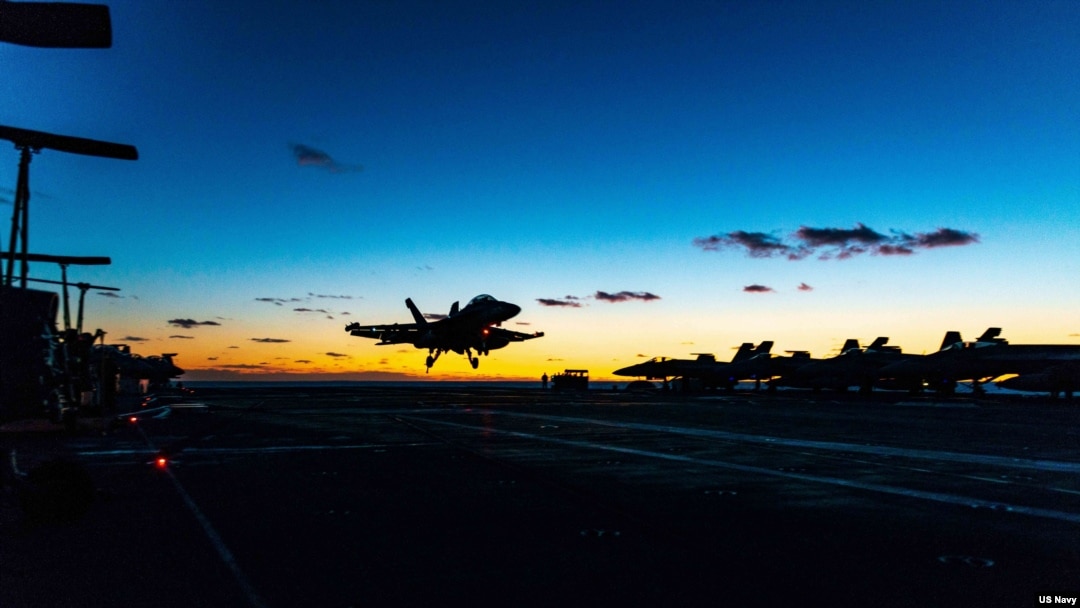North Korea fired two more short-range ballistic missiles (SRBM) early Thursday, as diplomats at the U.N. Security Council were locked in debate over how to respond to the launch of another missile over Japan two days earlier.
North Korea's latest ballistic missile test marked the sixth in 12 days, and came hours after a U.S. aircraft carrier, the USS Ronald Reagan, returned to waters near South Korea for additional trilateral naval drills.
Japanese Prime Minister Fumio Kishida Thursday decried the volley of missile fire as "absolutely unacceptable."
Defense Minister Yasukazu Hamada said the latest missiles "likely flew at an irregular trajectory," reiterating that the escalation of "provocative actions… is a threat to peace and security of [Japan], [the] region and the international community."
The two missiles launched Thursday appear to be of different types. One flew 350 kilometers with a maximum altitude of 80 kilometers and the other traveled 800 kilometers at a top altitude of 60 kilometers, according to South Korea's Joint Chiefs of Staff (JCS).
They were launched into the East Sea, also called the Sea of Japan, between 6:01 a.m. and 6:23 a.m. local time from North Korea's Samchok area in Pyongyang, JCS said, an area mentioned for the first time.
During a 25-minute phone call Thursday evening, Japan's Kishida and South Korean President Yoon Suk Yeol jointly condemned North Korea's action. Calling the missile tests "reckless," the two leaders agreed to make clear to Pyongyang that provocation will be met with consequences, Seoul's top office said.
SEE ALSO: In Escalation, North Korea Fires Ballistic Missile Over JapanNorth Korea Breaks Silence
In its first commentary since the ballistic missile tests began on September 25, North Korea’s foreign ministry issued a brief statement Thursday, using state media KCNA, strongly condemning the United States and its “satellites” for “unwarrantedly referring” North Korea to the U.N. Security Council.
The statement called the missile tests “just counteraction measures” against South Korea-U.S. joint drills that escalated “military tensions on the Korean peninsula.”
The U.S. was “posing a serious threat to stability” in the region by redeploying the USS Ronald Reagan to the Korean Peninsula, the statement said.
Trilateral Naval Exercises, Part II
Seoul’s Joint Chiefs of Staff later said an exercise at sea among the U.S., Japan and South Korea had resumed, aimed at responding to a hypothetical ballistic missile attack by North Korea.
The East Sea exercise brought back the USS Ronald Reagan carrier strike group, which had concluded a one-day trilateral exercise with Japan Sept. 30, preceded by bilateral exercises with South Korea Sept. 26 through 29.
The JCS said the defensive exercise involving South Korea’s Sejong the Great Aegis destroyer and Japan’s JS Chokai destroyer, would look to master the detection, tracking and interception of enemy fire.
Emboldened
North Korea’s missile tests suggest North Korea’s leadership has become emboldened, and not as fear-struck by U.S. supercarriers as in years past, says Park Won-gon, North Korean Studies professor at Ewha Womans University in South Korea.
In addition to advancements made to its nuclear capability, Park says North Korea is taking notes from Russia’s invasion of Ukraine and dealings with the West.
“The international environment and world politics right now is very favorable to North Korea, and North Korea has not missed this chance to develop their nuclear weapon,” Park said. “And their final goal, of course, is to be recognized by the international community as a de facto nuclear weapons state.”
A group of North Korean military aircraft -- eight fighter jets and four bombers – were also spotted flying in formation, the JCS said, presumed to be conducting air-to-surface firing drills north of the border dividing the two Koreas. The JCS said as the group moved further south, closer to a buffer zone, the South Korean Air Force scrambled an "overwhelming" response of 30 fighter jets. Though it did not escalate to an altercation, it was a rare moment of nerves, even as the carrier strike group and destroyers were engaged in an exercise of their own in waters to the east.
An emergency meeting Wednesday of the U.N. Security Council on North Korea’s missile test overflying Japan ended without a joint resolution, as Russia and China both dismissed the idea of preparing additional economic sanctions as “ineffective.”
SEE ALSO: Japan, South Korea Urge UN Security Council Response to North KoreaA joint statement condemning North Korea spearheaded by U.S. Ambassador Linda Thomas-Greenfield and joined by Albania, Brazil, France, India, Ireland, Japan, Norway, South Korea, the United Arab Emirates and the United Kingdom, however, was issued.


